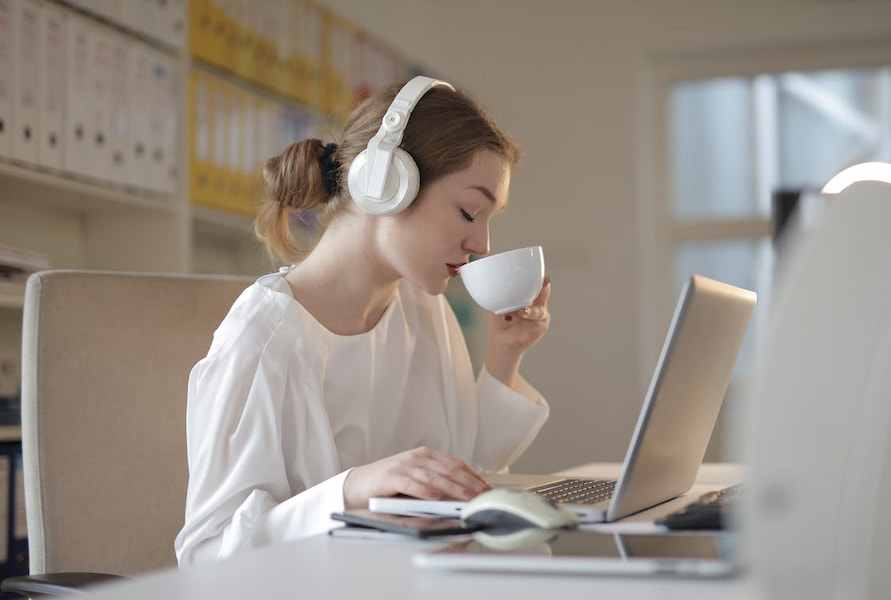Active sitting is basically engaging in physical activities that enable the core muscles to work while you are performing your job. It eliminates the dangers of sedentary lifestyle brought about by long periods of sitting. This is what make standing desks an essential furniture for working individuals at this time.
From a study in April 2016 entitled The Hidden Benefits of Standing Desks, a team of researchers at the University of British Columbia proved that standing desks indeed promote good health in the user. Similarly, under-desk exercise machines, though effective, can introduce distractions and disruptions to the office environment.

Active Sitting: An Overview
Active sitting is an approach that encourages subtle movements and posture adjustments throughout the workday, effectively promoting physical activity while maintaining a seated position. An active sitting chair is designed with ergonomic features and dynamic support to facilitate these movements. You can work comfortably and productively while subtly engaging your core muscles and improving circulation.
Active Sitting: A Misnomer or a Path to Workplace Wellness?
The term “active sitting” might sound like a marketing gimmick, a buzzword coined to keep office workers alert during long, tedious meetings. The idea of being “active” while seated seems paradoxical, almost nonsensical. However, beyond the catchy phrase lies a concept with significant implications for workplace wellness.
Active sitting, in essence, is a method of sitting that engages the core muscles more frequently than traditional seated postures. Our core, the central pillar of our body, comprises muscles in our back, sides, abdomen, and chest, working in unison to maintain proper alignment.
When we sit in conventional office chairs, these core muscles remain largely inactive. We often lean against the backrest, conforming our posture to the chair’s shape. This prolonged static position can lead to a host of musculoskeletal issues, making ergonomic office chairs crucial for preventing spine damage.
The perils of prolonged sitting extend far beyond mere discomfort. When you remain seated for extended periods, your muscles, deprived of regular movement, begin to atrophy, gradually losing their strength and function. This muscle inactivity also triggers a cascade of physiological changes within your body.
Your organs, no longer challenged by the demands of physical activity, slow down their operations, including your pancreas. The pancreas, however, remains diligently at work, producing insulin even when your body’s energy needs are low. This excess insulin secretion contributes to weight gain and, over time, can lead to the development of diabetes.
Active sitting seeks to counteract the detrimental effects of prolonged sitting by incorporating principles of motion that mimic those of standing and walking. When you stand or move around, your core muscles are constantly engaged in subtle adjustments to maintain balance and upright posture.
This interplay between muscles and the vestibular system, responsible for balance, is crucial for our ability to navigate the world on two legs. Even minor disruptions such as the loss of a toe or an inner ear imbalance can significantly impair balance and the ability to make these micro-adjustments.
Research has shown that when standing, we make postural adjustments 2-3 times per minute, and even more when in motion. This was concluded by a group of researchers from Oxford University Press, Oxford entitled Control of Equilibrium in Humans: Sway over Sway.
Also called postural sway, these frequent micro-adjustments keep your core muscles active and prevent them from falling into a state of dormancy. Active sitting aims to replicate this pattern of dynamic movement while remaining seated, effectively reawakening our core muscles and counteracting the negative effects of prolonged sitting.

Why You Should Try Active Sitting
- Promotes a Healthy Spine.
Active sitting reduces spinal compression. Prolonged static sitting can put a lot of pressure on the spine, especially in the lower back. Active sitting helps to keep the spine in a more neutral position, which reduces pressure on the discs and vertebrae.
- Strengthens the Core Muscles.
The core muscles are responsible for supporting the spine and maintaining proper posture. Active sitting engages these muscles, which helps to strengthen them and improve spinal stability.
- Enhances Blood Flow
Active sitting promotes better circulation throughout the body, including the spine. This helps to deliver nutrients and oxygen to the spinal tissues, which is important for maintaining spinal health.
- Improves Posture
Active sitting encourages a more upright posture, which helps to align the spine and reduce strain on the muscles and ligaments.
- Helps Burn Calories
Active sitting helps burn calories by increasing your metabolic rate. When you move your muscles, you burn calories. Even small movements can make a difference. Active sitting can also help you burn more calories by increasing your non-exercise activity thermogenesis (NEAT). According to Harvard Medical School’s Harvard Health Publishing, NEAT is the energy you expend in everyday activities that are not considered exercise.
- Initiates Mental Focus
When you sit actively, you’re engaging your core muscles and making small movements. This increases blood flow to your brain, which delivers essential nutrients and oxygen. As a result, your cognitive function is improved, including concentration and focus.
- Increases Flexibility
Active sitting involves making small movements throughout the day, which helps to keep the muscles and joints flexible. Thus, stiffness and pain in the back and neck is prevented.
Simple Active Sitting Exercises You Can Try
Incorporate these simple exercises into your daily routine to enhance the benefits of active sitting:

- Walking
Every 30-60 minutes, take a break to get up and walk around. Walking helps with circulation and joint pain and it gives you a good excuse to do more intense stretches or exercise.
- Stretching
A wide range of stretches, both seated and standing, can help a lot with pain in muscles. Pay particular attention to specific muscles that ache. For example, if you have pain in your lower back, you can try a seated hamstring stretch.
- Knee Lifts
Periodically stretch and lift a leg so your knee reaches towards your chest. Hold for a few seconds, and then let it back down. This exercise is a great way to stretch your hip flexors and hamstrings.
- Leg Lettering
Lift one leg off the ground and draw the letters of the alphabet with it. Then, put it down and repeat with the other leg. Leg lettering stretches and strengthens your hamstrings, quads, and hip flexors.

5 Features of an Active Sitting Stool You Should Check
With a wide variety of active sitting stools on the market, selecting the right one can be a daunting task. Here are some key features to consider when making your decision:
1. Adjustable Height
Adjustable height is a must-have feature for an active sitting stool. This allows you to transition seamlessly between sitting and standing positions, ensuring that your body remains engaged and your core muscles are activated throughout the workday.
Some stools offer a limited range of adjustment, making them suitable for sitting but not fully reaching a standing height. For optimal versatility, opt for a stool with a wide height adjustment range that can accommodate both sitting and standing positions.
2. Non-slip Rubber Feet
Active sitting, by its very nature, involves constant micro-movements and postural adjustments. To maintain stability and prevent accidents, a non-slip rubber foot is essential.
These feet provide a firm grip on the ground, ensuring that the stool remains stationary even when you’re shifting your weight or making subtle movements. Avoid stools with smooth or slippery feet, as these can easily slide out from under you, posing a safety hazard.
3. Weighted Base
For the same reason as a non-slip foot, you want your active sitting stool to have a weighted base. This helps to keep the center of gravity low and stable, minimising the chances of the stool tipping over when you’re making micro-movements or transitioning between sitting and standing postures.
A weighted base provides a sense of security and stability, allowing you to focus on active sitting without worrying about your stool moving unexpectedly.
4. Contoured Seat Edges
The seat edges play a crucial role in the comfort and ergonomics of an active sitting stool. Flat tops and hard edges, commonly found on bar stools, are not suitable for active sitting. These hard edges can dig into the backs of your thighs, causing discomfort, pain, and restricted circulation.
Opt for a stool with contoured seat edges that provide a smooth, rounded transition from the seat to the sides. This design will alleviate pressure on your thighs, allowing for comfortable and dynamic movement throughout the workday.
5. Cushioned Seat
The seat of your active sitting stool is crucial for comfort and support. Since you’ll be spending a significant amount of time seated, you’ll want a plush enough cushion to keep you comfortable while allowing for dynamic movement.
A thin or poorly padded seat can lead to discomfort and pain, especially during extended periods of use. Choose a stool with a thick, supportive cushion that provides adequate cushioning for your weight and allows for a comfortable seated position.

Are There Alternatives to an Active Sitting Stool?
While active sitting stools have gained popularity for their ability to promote dynamic movement and combat the negative effects of prolonged sitting, there are other options worth considering.
- Balance Balls
Also known as yoga balls, balance balls are often suggested as an alternative to active sitting stools. However, studies have shown that their stability can limit the active sitting experience.
In addition, their fragility makes them unsuitable for extended periods of use, as they are primarily designed for sporadic workouts. Moreover, their lack of height adjustability restricts their versatility and may not be suitable for individuals of all heights.
- Kneeling Chairs
Ergonomic kneeling chairs offer a unique seating posture, resembling an inverted “V” shape. The user sits on an angled pad while their knees and shins rest against another angled pad, with their feet elevated.
While kneeling chairs encourage some active sitting by engaging core muscles, their design can make it challenging to enter and exit the chair. Also, prolonged use can lead to restricted blood flow in the legs, causing numbness and tingling.

Final Thoughts
Active sitting offers a compelling solution to the detrimental effects of prolonged sitting. By incorporating dynamic movement into your seated posture, you can effectively counteract the negative impacts of a sedentary lifestyle and promote overall well-being. Embrace the benefits of active sitting and experience a healthier, more energised, and productive work life.
- 6 Benefits of Using Seat Cushion - February 20, 2024
- 4 Tips to Fix Uncomfortable Chair - February 19, 2024
- How to Position Lumbar Support on Ergonomic Chair - February 15, 2024

